AFGHANISTAN
Population

Population

Cities in AFGHANISTAN
| Kabul |
Population
General
The last official census in Afghanistan was in 1979 when the country had a population of 15,551,358. More than 37,.5 million people currently live in Afghanistan (2021 estimate). Afghanistan is a sparsely populated country with a population density of about 60 inhabitants per square kilometer. The number of 37.5 million inhabitants is only a rough estimate, because the war(s) in Afghanistan killed or fled millions of Afghans (4-8 million). According to the UNHCR, nearly six million refugees have returned to Afghanistan since 2002.
Since the late 1970s, Afghanistan has been in a more or less permanent war situation, and millions of Afghans have died in the meantime. The number of lightly and seriously injured and traumatized Afghans can no longer be counted. Add to that the perhaps five million Afghans who fled their country in the 1980s to Pakistan, Iran, but also to Europe and the United States, and it will be clear that almost every Afghan was facing the war.
Just a few generations ago, most Afghans lived in the countryside, nowadays urbanization is increasing. The four largest and most important cities are located spread across the country: Mazar-i Sharif (approx. 320,000 inhabitants) in the north, the capital Kabul (approx. 3 million inhabitants) in the east, Kandahar (approx. 400,000 inhabitants) in the south and Herat (approx. 420,000 inhabitants) ) in the west.
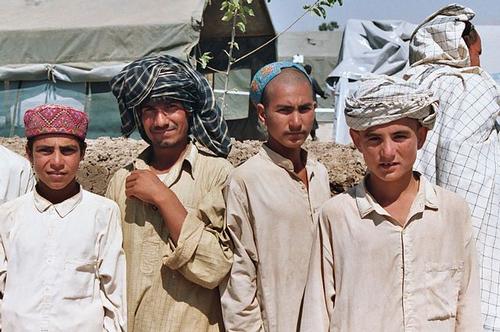 Afghans with traditional headgearPhoto: Chitrapa in the public domain
Afghans with traditional headgearPhoto: Chitrapa in the public domain
Natural population growth is 2.34%. (2021)
Birth rate per 1000 inhabitants is 36.08 (2021)
Death rate per 1000 inhabitants is 12.57 (2021)
Life expectancy is 51.7 years for men and for women 54.9 years (2021)
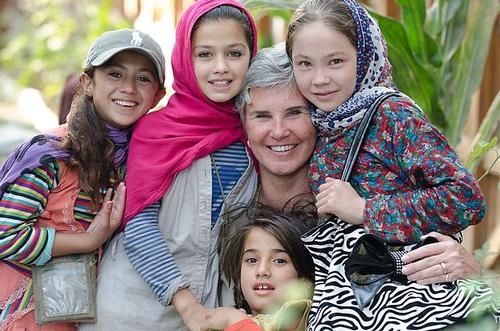 Girls AfghanistanPhoto: Sgt. Christopher Harper in the public domain
Girls AfghanistanPhoto: Sgt. Christopher Harper in the public domain
Ethnic groups
Afghanistan has a very varied population composition, on the one hand due to its location at a crossroads of migration routes, on the other hand due to the geographical conditions of the country with its many mountains and remote valleys. As a result, in addition to countless dialects, more than fifty different languages are spoken in Afghanistan. Most of the ethnic groups in Afghanistan are Indo-Iranian or Turko-Mongol, generally depending on what language they speak. In Afghanistan it is certainly not the case that there are straight lines between the different population groups, inter-ethnicity is not commonplace , but it certainly occurs regularly. Unfortunately, due to the civil war, the dividing lines between the various population groups have tightened again.
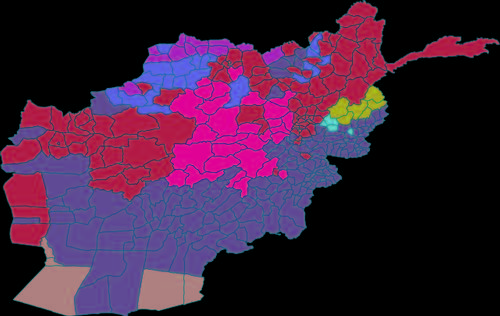 Ethnic Groups in AfghanistanPhoto: Public domain
Ethnic Groups in AfghanistanPhoto: Public domain
- Explanation on map:
Pashtun (dark blue): 42%
Tajiks (red): 27%
Hazaras (pink): 9%
Uzbeks (blue): 9%
Turkmen (purple): 3%
Baloch (light brown): 2%
others: Indo-Iranian populations: 8%
PATHANS or PASHTUN
The Pashtuns are by far the largest ethnic group in Afghanistan with about 12 million people and are also an important group in Pakistan. Since 1893 the Pashtuns have been separated after the establishment by the British of the so-called Durand line. Former President Hamid Karzai was a Pashtun and leader of an important tribe from the area of Kandahar, the main Pashtun city. The Pashtuns have a tribal structure, the largest confederations of which are the southern and southwestern Durranis and the eastern and southeastern Ghalji or Ghilzai. To break the power of the Pashtuns during the reign of Amir Rahman Khan (1880-1901), many Pashtuns were forced by the military to move to northern Afghanistan. These northern Pashtuns were again forced to flee south after the fall of the Taliban regime in 2001.
The Durranis, who mainly live in the south, southwest and east, are the most powerful group, but not the largest group of Pathans. Important Durrani tribes are the Popalzi and the Barakzi, the richest and largest group. Former President Zahir Shah was a Barakzi, as was his cousin Daud, who ousted him in 1973. To the north of Kandahar live the Popalzi, Ahmad Shah Durrani was a Popalzi, just like former president Hamid Karzai. The two groups are not really peaceful with each other, there are many problems and irritations among themselves. In addition to the tribes mentioned above, there are many others, including Ghilzai, Afridi, Sadozai, Yusufzai, Waziri, Mohammadzai and Kandahari.
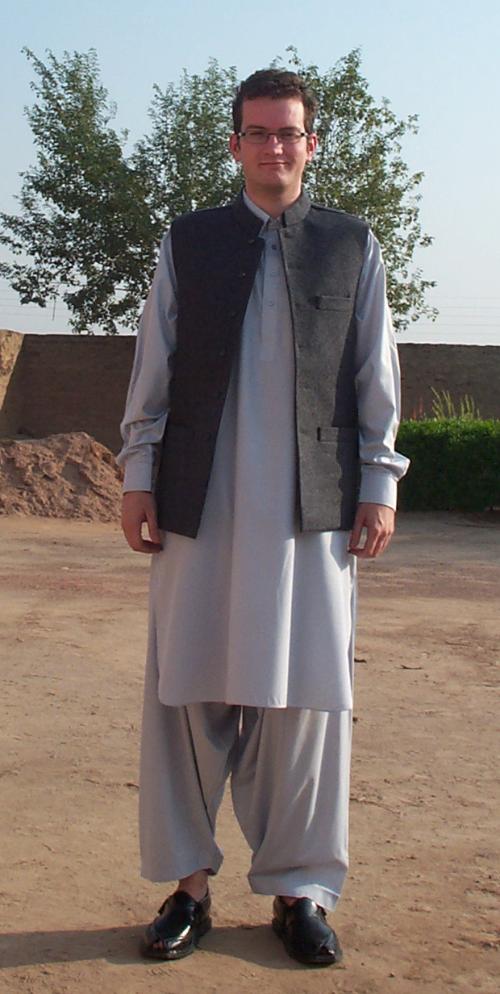 Typical Pathan clothingPhoto: Kai Hendry from Woking UK CC 2.0 Generic no changes made
Typical Pathan clothingPhoto: Kai Hendry from Woking UK CC 2.0 Generic no changes made
Traditionally a people of nomads, the Ghalji live mainly in eastern Afghanistan, between the cities of Kabul and Kandahar. The 'capital' of the Ghalji, they outnumber the Durranis, is Ghazni.
TADZJIKEN
There are probably about ten million Tajiks in Afghanistan, a large group, but only after the fall of the Taliban regime became politically more influential. They were already in Afghanistan when the Pashtuns, Uzbeks and Turkmen were yet to come. The Tajiks, a people without a tribal structure, speak Dari, a Persian language and mainly live in the mountainous, somewhat remote region of Badakhshan. In the southeastern province of Paktika, a small group of Tajiks still lives around the city of Urgun. The renowned Mudjahedin leader Ahmad Shah Massud was a Tajik. The isolated Mountain Tajiks, also known as Pamiris or Ghalchas, live in the early northeast of Afghanistan. Most of the Mountain Tajiks are Ismaili, a variant of Shia Islam, in religion. They speak a number of Iranian languages, including Wakhani.
AIMAK
Western Afghanistan is home to the Sunni Aimak, a group of nomadic and semi-nomadic tribes, including the Farsiwan and the Firuzkuhi, who mainly live around the city of Herat.
BALUCHIS
The Sunni Baluchis migrated from the south to southwest Afghanistan at the end of the 18th century. About half a million Baluchis live in Aghanistan, most Baluchis live in the Pakistani province of Baluchistan, but also in Iran. The Baluchis speak Baluchi, an Iranian language. The region of the Baluchis is also home to the Brahui, a people who originally also come from the Pakistani Baluchistan.
NURISTANIS
The Nuristani or Kafiris, virtuoso woodworkers, live in the wild, mountainous Nuristan area in eastern Afghanistan and differ ethnically and culturally from the rest of Afghanistan. Remarkably, many Nuristani have blonde or red hair and blue or green eyes. According to their own words, this is due to their ancient Greek roots.
The Nuristani, currently several hundred thousand individuals with their own Indo-Iranian language related to the Sanskrit of Northern India, were originally non-Islamic, but converted to Islam in the early 20th century. Kafiris who adhere to their original religion still live in Pakistan.
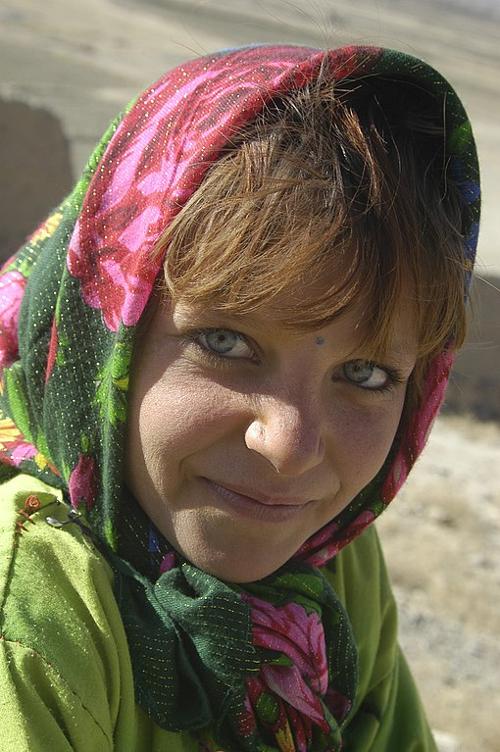 Nuristani girlPhoto: Barbara Millucci CC 2.0 Generic no changes made
Nuristani girlPhoto: Barbara Millucci CC 2.0 Generic no changes made
PASHAI
The several hundred thousand Pashai are neighbors of the Nuristani, as it were, living in roughly the same area and in the past also in the valley of the Kabul river, but have been largely displaced there by the Pashtuns. The Pashai speak an Indian language.
QIZILBASH
The approximately 50,000 Shia Qizilbash live mainly in the capital Kabul and in the city of Kandahar, and descend from Turkmen immigrants who came from the 18th century. Iran to Afghanistan.
Turkish populations
TURKMENS
Most of the approximately Sunni Turmen live in northwestern Afghanistan and are mostly descendants of refugees who fled south from Russia and the Soviet Union in the late 19th and early 20th centuries. The Turkmen in Afghanistan speak Turkish-related Turkmen and generally belong to the Ersari and Tekke tribes.
UZBEKS
The approximately three million Uzbeks are also a Turkish-speaking population group, descended from 15th century Central Asian migrants. But even after the Russian Revolution in the early 20th century, many Uzbeks fled south to Afghanistan. Uzbeks often wear ikat robes like 'chapans', and to please the Uzbeks ex-president Karzai often wore a chapan.
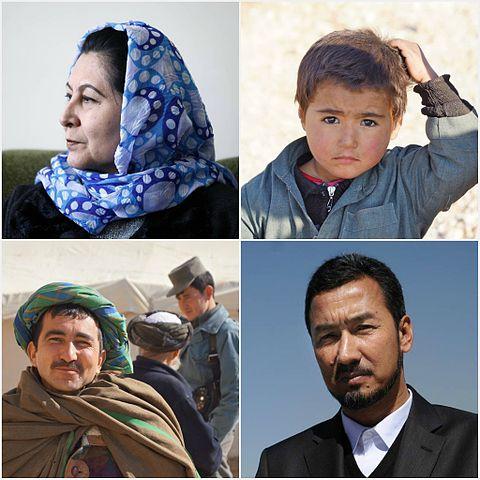 Ouzbek AfghansPhoto: Public domain
Ouzbek AfghansPhoto: Public domain
HAZARAS
Although the approximately three million Shia Hazaras belong to the Turkish population groups, they speak Dari. The area where they live is south of the Central Afghan mountains. The Hazaras are one of the poorest population groups in Afghanistan and are often troubled in their existence by Kuchis, a Pashtun nomadic tribe. The Sunni Taliban don't like the Shia Hazaras, and that has already cost many Hazaras their lives. Still, the Hazaras have generally managed to keep the Taliban out of their territory.
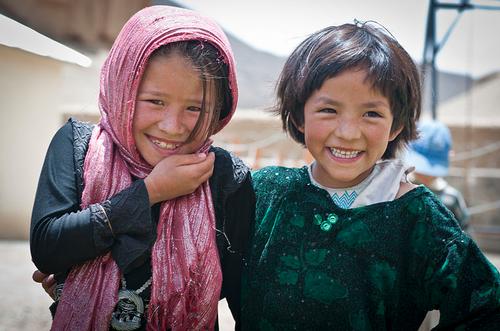 Hazara GirlsPhoto: Sgt. Ken Scar in the public domain
Hazara GirlsPhoto: Sgt. Ken Scar in the public domain
NOMADS
Since most of Afghanistan is arid and barren, it is not surprising that about 20% of the population is nomadic or semi-nomadic. "Kuchis," or "Powindahs," in fact Ghilzai-Pathans and the best-known group of nomads, head into the mountains with their herds every year. They are often at the bottom of the social ladder, but have recently become represented in the Afghan parliament and are proud of their extremely hard way of life. Nomadic men wear large turbans and are always armed with a dagger and a rifle. Nomadic women wear colorful robes over trousers and cover their heads with a long scarf. More often they also wear heavy silver bracelets, anklets and other jewelry.
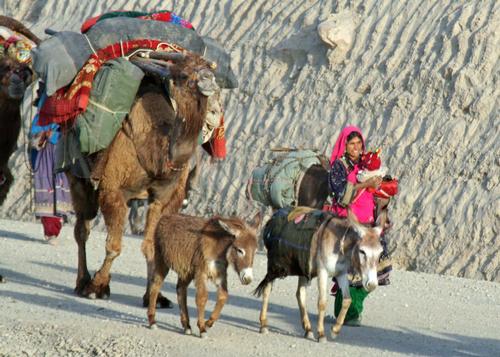 Kuchi nomads in Afghanistan are always on the goPhoto: Tech. Sgt. John Cumper in the public domain
Kuchi nomads in Afghanistan are always on the goPhoto: Tech. Sgt. John Cumper in the public domain
Sources
CIA World Factbook
BBC - Country Profiles
Elmar Landeninformatie
Clammer, Paul / Afghanistan
Lonely Planet
Copyright: Team The World of Info